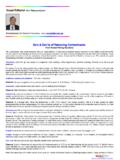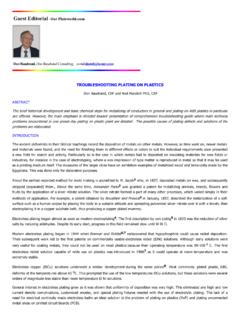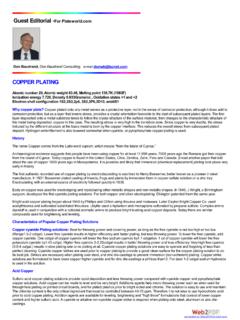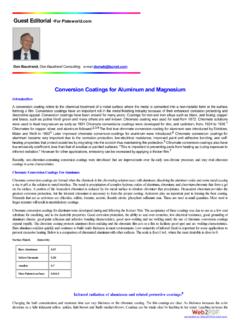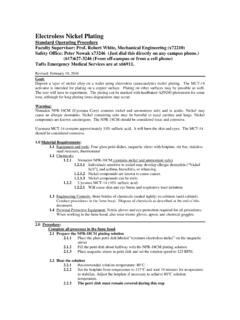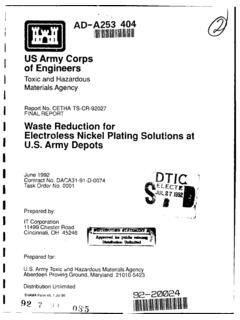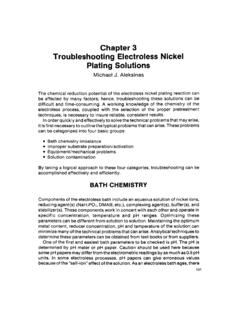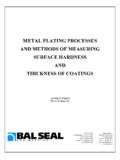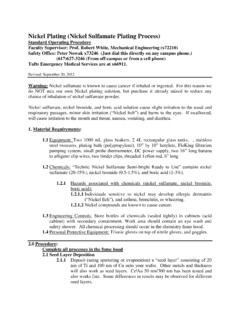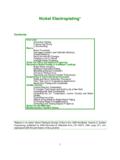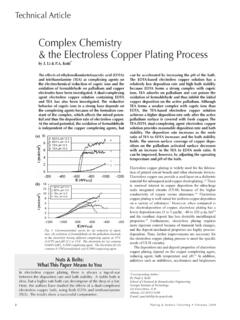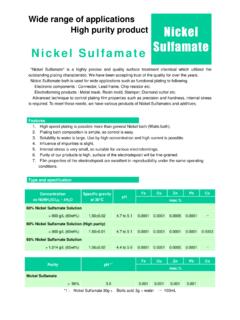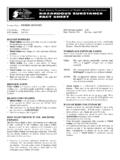Transcription of Treatment and Disposal of Spent Electroless Nickel Plating ...
1 Guest Editorial -For Don Baudrand, Don Baudrand Consulting, and Disposal of Spent Electroless Nickel Plating SolutionsDon Baudrand, Consultant, Poulsbo WashingtonDavid Crotty, PhD., MacDermid, Inc. New Hudson MichiganElectroless Nickel : How shall I treat thee? Let me count the ways. Elizabeth Barrette Browning would be overwhelmed by the number of ways to treat electrolessnickel, as are we. There are many different approaches to treating and Disposal of Spent Electroless Nickel solutions . This paper will discuss many of the methodsthat have been used with varying degrees of success in terms of the amount of Nickel left after Treatment . It is often wise to combine treatments, one followinganother. Examples include plate-out with palladium salts, plate-out with steel wool, borohydride induced plate-out, Nickel dust plate-out, Precipitation of metalsusing various precipitants, ion exchange, electrowinning, reverse osmosis and electrodialysis.
2 Which one should I use? How do they compare? Some of the prosand cons of each process will be Elizabeth Barrett Browning wrote her famous poem "How Do I love Thee" which starts "How do I love thee, let me count the ways" she had never heard ofelectroless Nickel . When Electroless Nickel Plating was introduced to the world in about 1947, most of us had never heard of the strict regulations in Treatment anddisposal of Electroless Nickel Plating solutions and rinse water. Today we are faced with many choices for the Treatment and Disposal of these Plating solutions andthe rinses necessary for the process. How do you choose the right process or combination of processes for your circumstances? A major input the decision makingprocess is being aware of the choices available. What are the choices today? Let us consider some of IWaste Treatment of Water RinsesCaustic soda (Sodium hydroxide) or magnesium hydroxide (Calcium oxide) or slaked lime (Calcium hydroxide and calcium carbonate).
3 Sulfide or thiocarbamate precipitationHigh pH chelate break up and precipitation Ion exchangeEiectrowinningReverse osmosisTable IIWaste Treatment of SpentSolutionsCaustic soda (Sodium hydroxide) or magnesium hydroxide precipitation. Lime (Calcium oxide) or slaked lime(Calcium hydroxide and calcium carbonate). Sulfide or thiocarbamate pH chelate break up and precipitation. Ion Life discussing the individual Treatment process, I want to emphasize the importance of good rinsing and water conservation. It is essential for quality work thatgood rinsing and efficient use of water is practiced. Counter flow rinse systems using three rinses produce nearly ideal rinsing conditions, and can use up to 90% lesswater than a single rinse tank producing the same quality of rinse water. Sometimes spray rinses over the tanks improve rinsing.
4 The combination of spray andimmersion rinsing is usually best. Treatment and reuse of rinse waters has advantages. The reuse or reclaim of Nickel is also possible and is good practice. It isimportant to be aware that Electroless Nickel solutions contain chelators (complexing agents) such as citrate, gluconates, glycolates, malates, lactic acid, andammonia, that will tie up other metals making them difficult to waste treat. Therefore, separating the effluent stream after Nickel removal is necessary. The effluentcontaining chelators should not be combined with any other waste streams unless the other effluents have been treated for metal removal. Sending the chelatecontaining waste stream directly to the sewer may be acceptable if phosphorus, sulfate and the bio oxygen demand (BOD) and chemical oxygen demand (COD)requirements are met.
5 The remaining ingredients in the effluent are bio degradable unless fluocarbon wetting agents are used, or other non biodegradableconstituents are added, usually not found in most proprietary Electroless Nickel water treatmentReferring to table I, each Treatment listed, or combination of treatments can produce acceptable results. The choice is based on the availability of equipment, space,costs, ease of operation, convenience, time of processing and federal and local regulations that may exceed federal soda, magnesium hydroxide or lime soda, magnesium hydroxide or lime treatments are done at pH 12.[ 2.] Slow additions are required due to the large amount of heat generated by theneutralization reaction. Flocculating agents are usually added and coagulation and settling times are long, typically 16 hours or more.
6 The costs are low. The sludgegenerated is large, compared with other Treatment systems, especially if lime (the lowest cost material) is used. After settling the supernatant liquid can decanted andthe sludge removed. Or the effluent can be filtered collecting the sludge on the filter cake. The sludge should be dewatered as much as possible. The sludge ishazardous waste that must be hauled to an approved hazardous waste land fill. Or if possible, reclaim the Nickel for or thiocarbamate precipitationSulfide removal of Nickel produces less sludge then alkaline precipitation, but results in an even more hazardous sludge due to the Nickel sulfide. Most land fillfacilities will not accept this waste material. Diethylthiocarbamate and similar proprietary products can reduce the Nickel level to very low values fairly quickly.
7 Thethiocarbamate treatments are usually reserved for polishing the effluent after most of the Nickel is removed by other Treatment methods. Ferrous sulfide and sodiumsulfide are a little less effective, but less expensive. Ferrous sulfide produces a larger volume of sludge than other sulfide or thiocarbamate treatments.[2.]High pH chelate break upHigh pH break up is done to free the Nickel from the chelates (complexing agents) so that Nickel can be easily precipitated as Nickel hydroxide more efficiently andmore completely than using lime or other hydroxide treatments alone. Chelates hold tightly onto Nickel at lower pH (4-6). The higher the pH, the more Nickel wouldbe released to precipitate. Destroying the chelate allow more Nickel to precipitate and at a faster rate. Chelates are organic compounds subject to oxidation byseveral processes.
8 Included are ozone, potassium permanganate and chlorine, or sodium hypochlorite. Ozone is three oxygen atoms tied together and provide apowerful oxidizing (destroying ) agent. Ozone generators are available and not too expensive to purchase and operate. Potassium permanganate in an alkalinesolution is another strong oxidizing agent. It produces manganese sludge and cause purple stains on most anything it contacts. Alkaline chlorination as used to treatcyanide waste can also be used to destroy chelators. It takes a longer time and more chlorine or hypochlorite to complete the destruction of the chelators comparedwith the destruction of ExchangeIon exchange can remove Nickel and other metal ions from the rinse waters. If done properly, the water can be reused for rinsing. Both cation and anion exchangeresins must be used to remove both metals and non metals.
9 Ion exchange can be supplemented by reverse osmosis or electrodialysis. Another ion exchange processcalled "Starch Xanthate",[3] is an insoluble material that can be added to a filter or to the water in a retention tank. It exchanges sodium for Nickel . The removal isalmost instant and leaves little residual heavy metals. It can be used for batch or continuous flow systems by pre- coating a is a term used to describe Plating metal from a solution for recovery purposes. The water containing Nickel is introduced to a Plating cell with manyanodes and cathodes. DC current and voltage is applied and Nickel is deposited on the cathode. The cathodes may be stripped of Nickel from time to time, and thenickel reused. Sulfuric acid/peroxide is often used for stripping. The current efficiency is low, therefore the cost of electricity is a OsmosisReverse osmosis is a process that can concentrate Nickel solutions .
10 It works by applying a pressure on a salt solution ( Nickel salts such as Nickel sulfate) in thepresence of a semi permeable membrane. Pure water is forced through the membrane leaving concentrated Nickel salts behind. The concentrated Nickel can bereturned to the Plating tank. Multi pass cells are an efficient way to utilize reverse borohydrideTo treat waste rinse water, maintain the pH between S and 11. Add the sodium borohydride solution slowly. The amount of borohydride to remove 1 gram ofnickel is theoretically grams. However the borohydride reacts with other metals and some organics thus requiring about two times the expected amount. Thesodium borohydride is added as a 12% solution in 43% sodium hydroxide. Additional sodium hydroxide is often needed to maintain the pH between 8-11. Theadvantages are low cost, good efficiency , and good removal from chelating agents.
